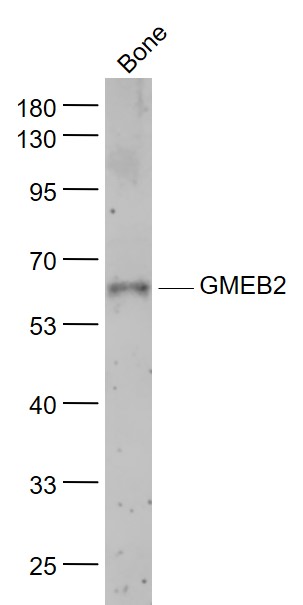
Rabbit Anti-GMEB2 antibody
GMEB2; DNA binding protein p79PIF; DNA-binding protein p79PIF; Glucocorticoid modulatory element binding protein 2; Glucocorticoid modulatory element-binding protein 2; GMEB 2; GMEB-2; Gmeb2; GMEB2_HUMAN; KIAA1269; P79PIF; Parvovirus initiation factor p79
View History [Clear]
Details
Product Name GMEB2 Chinese Name 糖皮质激素调节元件Binding protein2抗体 Alias GMEB2; DNA binding protein p79PIF; DNA-binding protein p79PIF; Glucocorticoid modulatory element binding protein 2; Glucocorticoid modulatory element-binding protein 2; GMEB 2; GMEB-2; Gmeb2; GMEB2_HUMAN; KIAA1269; P79PIF; Parvovirus initiation factor p79; PIF p79; PIF79; RP4 663D7.1. literatures Research Area Cell biology Chromatin and nuclear signals Signal transduction Transporter Epigenetics Immunogen Species Rabbit Clonality Polyclonal React Species Mouse, (predicted: Human, Rat, Chicken, Dog, Cow, Horse, Rabbit, Sheep, ) Applications WB=1:500-2000 ELISA=1:5000-10000 IHC-P=1:100-500 IHC-F=1:100-500 ICC=1:100-500 IF=1:100-500 (Paraffin sections need antigen repair)
not yet tested in other applications.
optimal dilutions/concentrations should be determined by the end user.Theoretical molecular weight 56kDa Cellular localization The nucleus cytoplasmic Form Liquid Concentration 1mg/ml immunogen KLH conjugated synthetic peptide derived from human GMEB2: 101-200/530 Lsotype IgG Purification affinity purified by Protein A Buffer Solution 0.01M TBS(pH7.4) with 1% BSA, 0.03% Proclin300 and 50% Glycerol. Storage Shipped at 4℃. Store at -20 °C for one year. Avoid repeated freeze/thaw cycles. Attention This product as supplied is intended for research use only, not for use in human, therapeutic or diagnostic applications. PubMed PubMed Product Detail GMEB-2 is a DNA-binding protein that plays a crucial role modulating transcription upon activation by steroid hormones. GMEB-2 is ubiquitously expressed with preferential expression in developmentally important tissues, such as testis, bone marrow, placenta and fetal tissues. It localizes to the nucleus and cytoplasm and contains a SAND domain near its N-terminus and a C-terminal coiled coil structure. GMEB-2 functions as a homodimer or as a heterodimer with GMEB-1. The formed complex specifically binds to glucocorticoid modulatory elements (GME) in the promoter region of target genes and recruits the histone acetylase CREB binding protein (CBP) during glucocorticoid signaling. This acts to increase sensitivity to low concentrations of glucocorticoids. In addition, GMEB-2 functions as an auxiliary factor required for parvovirus replication.
Function:
Trans-acting factor that binds to glucocorticoid modulatory elements (GME) present in the TAT (tyrosine aminotransferase) promoter and increases sensitivity to low concentrations of glucocorticoids. Binds also to the transferrin receptor promoter. Essential auxiliary factor for the replication of parvoviruses.
Subunit:
Homodimer, and heterodimer of GMEB1 and GMEB2. GMEB1 and GMEB2 form the parvovirus initiator complex (PIF). Interacts with the glucocorticoid receptor (NR3C1). May interact with CREB-binding protein (CBP).
Subcellular Location:
Nucleus. Cytoplasm. May be also cytoplasmic.
Tissue Specificity:
Expressed in peripheral blood lymphocytes and fetal liver. Expressed preferentially in reproductive and/or developmentally important cells, such as testis, placenta, bone marrow and fetal tissues.
Similarity:
Contains 1 SAND domain.
SWISS:
Q9UKD1
Gene ID:
26205
Database links:Entrez Gene: 26205 Human
Omim: 607451 Human
SwissProt: Q9UKD1 Human
Unigene: 473286 Human
Product Picture
References (0)
No References
Bought notes(bought amounts latest0)
No one bought this product
User Comment(Total0User Comment Num)
- No comment



 +86 571 56623320
+86 571 56623320
 +86 18668110335
+86 18668110335

